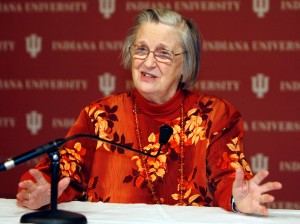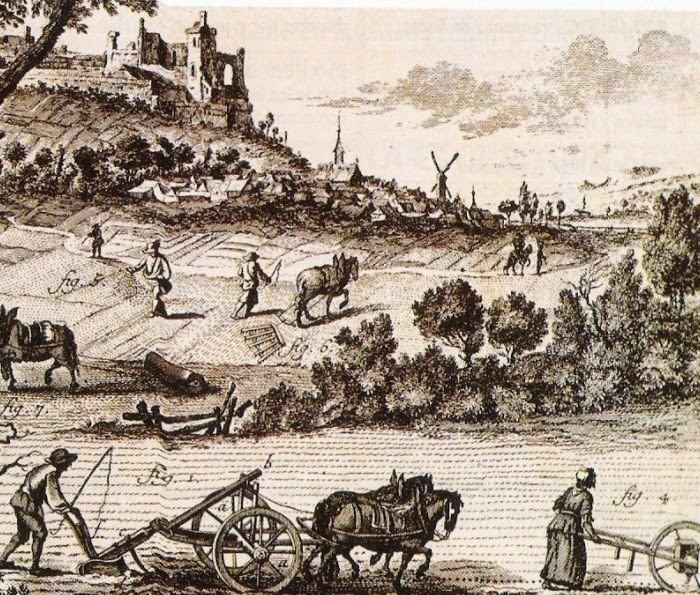The “Naturalness” of the Commons
ECONOMICS, 23 Mar 2015
David de Ugarte – TRANSCEND Media Service
Why so much sudden love for Elinor Ostrom? Did people really think before that the commons was impossible? Wasn’t the countryside full of communal lands and herds?
18 Mar 2015 – When you live in a community, you see how it’s the most natural and spontaneous thing in the world that everything is shared, that everything must strengthen everyone to work… and precisely because of that, it never seems like a big thing, it doesn’t seem to have a special value, it’s “spontaneous,” “normal.” But when you go to the everyday institutions of society — the businesses, the communities of neighbors, the administration — it’s hard to find an iota of everything that you take for granted, and you wonder if it really is as “natural” as it seemed to you.
But if we think about it a bit, that “naturalness” is quite present in our culture. All languages have a specific word for communal work: in Spanish, using the Asturian word, we call it “andecha;” in Portuguese, “mutirão;” in Euskera [Basque], “auzolan;” in Russian, “toloka;” in Finnish, “talkoot;” in Norwegian, “dugnad“… And also for community property: the traditional peasant common lands and associations of fishers, or “procomún,” as it begins to be called in the fifteenth century in Spain, is equivalent to the Japanese “iriai,” or the English “commons.”
That’s because agricultural and hunting commons are the original form of ownership and work, long prior to State property and private property… and for the time being, the most persistent: commons institutions remained vigorous throughout the world up through the Middle Ages and resisted Modernity with relative strength until the “amortization” of nineteenth-century liberalism forced them to evolve into modern cooperativism. But don’t be fooled: even today, there are large European regions, like Galicia, where more of the 25% of the territory is made up of common lands. We have always been surrounded by the commons and by community values. Our culture kept more than just the formula for us.
If it wasn’t enough to observe the survival of large expanses of communal land and herds on all continents, it must be said that in all of our community experience we’ve never found a single case where problems arise because someone had consumption patterns such that endangered common resources. In community life, there are problems and conflicts, but in our experience, that’s not one of them, and if it does happen somewhere, it certainly isn’t frequent or relevant.
The “Tragedy of the Commons”
And “The Tragedy of the Commons” has a trap. It is a theoretical model created in 1968 by Garrett Hardin, an neo-Malthusian ecologist, a forerunner of what would later be called “degrowth,” obsessed with what he believed to be an “excess of population.” Hardin starts with a definition of the behavior of individuals according to which they would look only at their short-term interests, but would be blind both to the social result (which is to say, the impact their actions would have on the sum of individual results) and on their own total results over time. The model also means that the commons in question is not reproducible (with free software, this is not applicable, because it doesn’t run out when we use it more).
With these initial restrictions, according to which people would literally behave as if there was no tomorrow and there were no other people — surprise, surprise! — the result is that the shared resource runs out. The results were implicit in the conditions of the game, and the result is the one that was desired: the “demonstration” that the reality that surrounds us doesn’t exist, because it is “irrational.”
This is a very different path from the one followed by the classical economists and Marx himself. They had not used an abstract and self-reinforcing model, but had had to explain and model why existed commons in a good part of the arable lands in Europe and, above all, why the peasants didn’t want privatize them. The history of the nineteenth century in large countries like Russia, Spain or Italy is the story of governments like that of the Spanish minister Madoz, trying privatize the commons by force, with little success. It was a drama for the liberals of the times, who thought that without individual property rights, the countryside would never become technological, nor would enough labor flow to the cities to make industry viable. It was a theoretical problem for Marx, who was continuously asked by those in Russia what to do with the countless peasant commons there, and whether they could evolve “directly” to an economy of abundance without going through privatization.
But, by 1968, when Hardin writes “The Tragedy of the Commons,” the commons is no longer a political problem. It is simply a settled reality that economic theory could explain easily, without the need to include internal regulations or external, whether with game theory, modeling the commons as Nash equilibria, or even with neoclassical theory, including the way that would make Gary Becker famous, models of long-term rationality.
Only in the Anglo-Saxon world, where the nineteenth-century amortizations were really effective and put an end to common ownership of the land, could Hardin’s story come to be “common knowledge,” because by 1968, nobody in the USA or Great Britain co-existed with common lands and shared usage. But in reality, these were part of the everyday geography of millions of inhabitants where neither had the liberal revolution ever totally triumphed in its agrarian policies, nor had Soviet or Chinese socialism been imposed — a large area which included, on a continuum, places as disparate as Indochina, Galicia, Mexico, la Araucania [Chile], or South Africa.
The self-interested sanctification of Elinor Ostrom
However, in 2009 the Swedish Academy gave the Nobel Prize in Economics to a political scientist, Elinor Ostrom,  for having “challenged conventional wisdom [sic] by demonstrating how local property can be managed by a local commons without regulation by central authority or privatization.” Ostrom soon became a sort of patron saint to all those in universities who were interested in the community experience in general and the commons in particular. The central idea they took from her work is that the management of the commons requires a complex set of norms and equilibria that remain “artificial,” products of a very sophisticated social construct.
for having “challenged conventional wisdom [sic] by demonstrating how local property can be managed by a local commons without regulation by central authority or privatization.” Ostrom soon became a sort of patron saint to all those in universities who were interested in the community experience in general and the commons in particular. The central idea they took from her work is that the management of the commons requires a complex set of norms and equilibria that remain “artificial,” products of a very sophisticated social construct.
This is true, but their political-academic claim is not disinterested: when a social organization is described as “artificial” and “sophisticated,” it is implicitly being argued that it is necessary to have “special,” academic, or “technical” knowledge to make it work. Ostrom thus became excuse to argue the guardianship of groups of theoreticians and academics over the social process, with their consequent industry of advanced degrees, courses, and seminars for training “specialists.”
Reality is stubborn
indianasBut 2009 was also the first real year of crisis in Europe. Millions of people were left without work. In countries like Greece, Spain or Portugal, thousands and thousands of families lost their houses. Spontaneously, the social network — first, families, and then, communities — started to reorganize for survival. Hundreds of small “communes” appeared, houses that were shared between families that had been left without regular income, in which everything that that was obtained went into a common fund. Nobody needed design or certify a sophisticated set of rules. While it was a precarious response to an emergency situation, the “naturalness” of the process is noteworthy. The model already was there, in the cultural inheritance and in the traditions of the working classes.
And that’s really the key: the community is, in point of fact, a sophisticated cultural construction. And what’s more, so are the traditions of sharing that are profoundly embedded in popular culture. When an egalitarian community is born, when we create a new commons to be shared, we’re not starting from zero. We are putting “into production” all that code, all that community rationality that we inherited from the learned reactions and way of managing common belongings in our families. That is why we experience it as “spontaneous,” why it feels “natural,” and why it appears again and again in such different environments all over the world. Our “rationality” is definitively not what Hardin and the neo-Malthusian theoreticians of degrowth attributed to us when they presented the irrational destruction of non-renewable resources as a product of our “nature” and not as the result of over-scaled corporations dedicated to looking for rents at all costs.
No, to understand the shared economy, to work together to manage the needs of all in a community economy, we don’t need great treaties or consultation with university technicians. We just need to go back home, back to basics.
_____________________________
David de Ugarte: Economist, technologist and entrepreneur committed to new models of economic democracy. Founder and theorist of the Spanish cyberpunk group (1989-2007), founder of Piensa en red SA (1999-2002) and later of the Cooperative Society of las Indias Electrónicas (2002) and of the Cooperative Group of las Indias, in which he’s in charge of new project development.
Translated by Steve Herrick from the original in Spanish.
Go to Original – lasindias.com
DISCLAIMER: The statements, views and opinions expressed in pieces republished here are solely those of the authors and do not necessarily represent those of TMS. In accordance with title 17 U.S.C. section 107, this material is distributed without profit to those who have expressed a prior interest in receiving the included information for research and educational purposes. TMS has no affiliation whatsoever with the originator of this article nor is TMS endorsed or sponsored by the originator. “GO TO ORIGINAL” links are provided as a convenience to our readers and allow for verification of authenticity. However, as originating pages are often updated by their originating host sites, the versions posted may not match the versions our readers view when clicking the “GO TO ORIGINAL” links. This site contains copyrighted material the use of which has not always been specifically authorized by the copyright owner. We are making such material available in our efforts to advance understanding of environmental, political, human rights, economic, democracy, scientific, and social justice issues, etc. We believe this constitutes a ‘fair use’ of any such copyrighted material as provided for in section 107 of the US Copyright Law. In accordance with Title 17 U.S.C. Section 107, the material on this site is distributed without profit to those who have expressed a prior interest in receiving the included information for research and educational purposes. For more information go to: http://www.law.cornell.edu/uscode/17/107.shtml. If you wish to use copyrighted material from this site for purposes of your own that go beyond ‘fair use’, you must obtain permission from the copyright owner.

